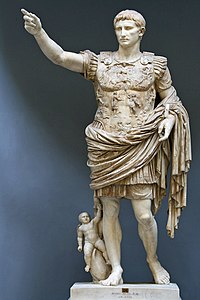Julio-Claudians
| Julio-Claudian dynasty Domus Iulio-Claudia |
|
|---|---|
| Imperial house | |

Bust of a Julio-Claudian prince.
|
|
| Country |
|
| Estates | |
| Parent house | Gens Julia & Gens Claudia |
| Titles | |
| Style(s) | "Imperator" "Caesar" "Augustus" |
| Founded | 27 BC |
| Founder | Augustus |
| Final ruler | Nero |
| Dissolution | AD 68 |
| Deposition | AD 68 (deposed by Galba) |
| Ethnicity | Ancient Roman |
| Roman imperial dynasties | |||
| Julio-Claudian dynasty | |||
 The statue known as the Augustus of Prima Porta, 1st century |
|||
| Chronology | |||
| Augustus | 27 BC – 14 AD | ||
| Tiberius | 14–37 AD | ||
| Caligula | 37–41 AD | ||
| Claudius | 41–54 AD | ||
| Nero | 54–68 AD | ||
| Family | |||
|
Gens Julia Gens Claudia Julio-Claudian family tree Category:Julio-Claudian dynasty |
|||
| Succession | |||
|
Preceded by Roman Republic |
Followed by Year of the Four Emperors |
||
The term Julio-Claudian dynasty refers to the first five Roman emperors—Augustus, Tiberius, Caligula, Claudius, and Nero—or the family to which they belonged. They ruled the Roman Empire from its formation under Augustus from 44 BC, until AD 68 when the last of the line, Nero, committed suicide.
Primogeniture is notably absent in the history of the Julio-Claudian dynasty. Neither Augustus, Caligula or Nero fathered a natural and legitimate son; Tiberius' own son, Drusus, predeceased him; only Claudius was outlived by his son, Britannicus, although he opted to promote his adopted son, Nero, as his successor to the throne. Adoption ultimately became a tool that most Julio-Claudian emperors utilized in order to promote their chosen heir to the front of the succession. Augustus, himself an adopted son of his great-uncle, the Roman dictator Julius Caesar, adopted his stepson and son-in-law Tiberius as his son and heir. Tiberius was, in turn, required to adopt his nephew Germanicus, the father of Caligula. Caligula adopted his cousin and Tiberius' grandson Tiberius Gemellus shortly before executing him; Claudius adopted his great nephew and stepson Nero, who, lacking a natural or adopted son of his own, ended the reign of the Julio-Claudian dynasty with his fall from power and subsequent suicide.
The ancient historians who dealt with this period—chiefly Suetonius (c. 69 – after 122 AD) and Tacitus (c. 56 – after 117 AD)—write in generally negative terms about their reign. Tacitus wrote of the historiography of the Julio-Claudian emperors:
Julius and Claudius were two Roman family names; in classical Latin, they came second. Roman family names were inherited from father to son, but a Roman aristocrat could – either during his life or in his will – adopt an heir if he lacked a natural son. In accordance with Roman naming conventions, the adopted son would replace his original family name with the name of his adopted family. A famous example of this custom is Julius Caesar's adoption of his great-nephew, Gaius Octavius.
...
Wikipedia
